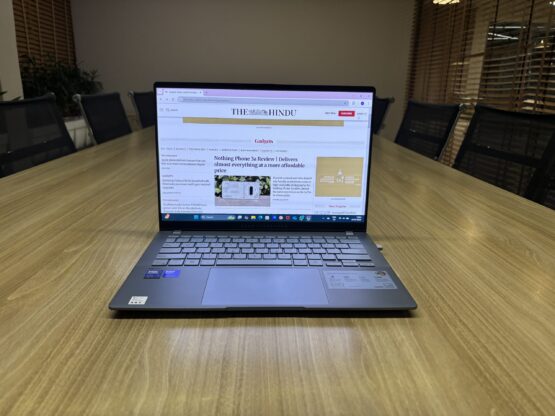A New Direction for the Vivobook Series
The ASUS Vivobook S 14 OLED is among the first wave of laptops built with AI capabilities at its core. It features Intel’s latest Series 2 processor, a 14-inch OLED display, and Windows 11 with Copilot+ readiness.
It also competes closely with ASUS’s Zenbook A14, offering a slightly different balance of design, performance, and price.
Design: Light, Durable, and Practical
The ASUS Vivobook S 14 OLED features a slim 1.39 cm profile and weighs just 1.3 kg. This makes it ideal for users who move around often. It has an all-metal body with a CNC-engraved logo that looks refined and professional. It doesn’t draw too much attention, but it feels solid.
The laptop passes US MIL-STD 810H tests for durability. So, it can handle daily bumps and knocks without issue. Students and professionals will find this a reliable pick.
It offers two USB 3.2 Gen 1 Type-A ports, two Thunderbolt 4 ports, an HDMI 2.1 port, a microSD card slot, and a 3.5mm jack. This wide selection helps eliminate the need for dongles.
Display: Crisp, Vivid, and Easy on the Eyes
The 14-inch Lumina OLED panel has a 1920×1200 resolution and a 16:10 ratio. Thin bezels and an 87% screen-to-body ratio enhance immersion.
It gets bright at 600 nits and supports HDR content with VESA DisplayHDR True Black 600. With 100% DCI-P3 color coverage, the screen works well for content creation. While the 60Hz refresh rate may not suit fast-paced gaming, it’s fine for everything else. The OLED panel also helps reduce blue light.
Keyboard and Touchpad: Smooth Everyday Use
The ErgoSense keyboard is comfortable. Keys have 1.7mm travel, which feels good when typing long documents. The RGB backlight helps in low-light settings. ASUS has also included a Copilot key for easy AI tool access.
The touchpad is responsive and supports gestures. It’s large enough to use comfortably and doesn’t pick up fingerprints easily.
Camera and Audio: Well-Suited for Remote Work
The Full HD IR webcam supports Windows Hello for face login. Background blur and other AI tools enhance video call quality. There’s a physical shutter for privacy.
The dual speakers are tuned by Harman Kardon and support Dolby Atmos. While sound quality is decent, the volume is limited due to internal placement.
Performance: Capable Hardware with Minor Stability Issues
This model uses the Intel Core Ultra 7-256V chip with 8 cores and a 4.8GHz boost. Intel Arc Graphics and a 47 TOPS NPU help power AI tasks like transcription and effects during calls.
With 16GB RAM and a 512GB SSD, it loads quickly and runs apps smoothly. It handles multitasking well. However, we faced a few random freezes during testing that required a restart. While not common, these could affect performance until fixed via updates.
ASUS uses its IceCool system to keep heat under control. Dual fans and heat pipes spread out the heat and prevent overheating.
Software and AI Features: A Step into the Future
The laptop runs Windows 11 Home and supports Copilot features. These tools help with organizing files, writing drafts, and summarizing content. Windows Studio Effects also improve webcam output.
ASUS adds its own tools like StoryCube for managing media and AI noise-canceling for calls. The system includes Microsoft Pluton and Passkeys for added security.
Battery Life and Charging: Travel-Friendly Setup
The 75Wh battery runs for about 8 hours on a full charge. That’s enough for most daily work. It charges quickly with the included 65W USB-C charger. ASUS Easy Charge allows the use of power banks, airline plugs, and standard USB-C adapters.
Verdict: A Capable Laptop with Room for Improvement
At a price of ₹99,990, the ASUS Vivobook S 14 OLED stands out for its display quality, lightweight design, and future-ready AI support. While overall performance is strong, occasional system freezes highlight the need for improved software optimization.
For students, professionals, and creatives who need portability and a solid display, this laptop is a worthy option. It’s especially appealing for users looking to explore AI-enhanced workflows without investing in high-end models.








Leave a Reply